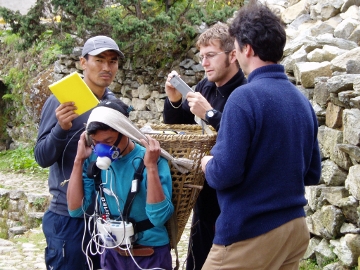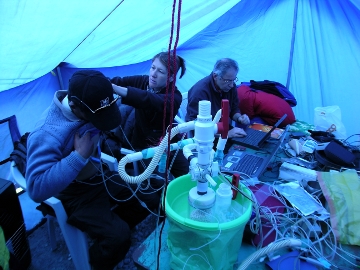












Respiratory health in high altitude residents exposed to indoor pollution.
Principal investigator: Dr. Valter Fasano – University of Milan, Institute for Respiratory Diseases.
Indoor pollution is a risk factor for Chronic Obstructive Pulmonary Disease (COPD). The aim of this study is to assess lung function, exercise capability, level of lung inflammation and oxidative stress in representative samples of population of villages at high altitude with no roads and industries so that the only effect of indoor pollution/smoking habits can be studied. At the beginning the study will be performed in Nepal, and the study may be expanded to Pakistan. A preliminary expedition was carried out in 2007.
The study will improve our understanding of the relationship between indoor pollution and respiratory health, to contribute to decreasing the morbidity and mortality from COPD in local populations. Study methods foresee non-invasive respiratory tests and exhaled CO measurements and a collection and analysis of sputum and exhaled air condensate from local subjects. The indoor pollution will be assessed through measurements of carbon monoxide. Following the analysis of the data, programs to prevent, diagnose and manage COPD will be proposed and implemented.
Mechanics and energetics of heavy load carrying on slopes: resource management in extreme conditions.
Principal investigator: Prof. Alberto Minetti – University of Milan, Institute of Human Physiology.
The aim of the project is to test the locomotor strategies in carrying high loads while walking on steep slopes in extreme hypoxia. It is hypothesized that Nepalese porters developed a sensibility allowing them to choose speed/gradient pairs which keep the muscular effort as constant as possible. Their ability in this task will be compared with professional Caucasian mountaineers who are expected not to have developed such skills. Two research expeditions have been already carried out and they unveiled that porters displayed better performances, better economy and better efficiency then Caucasian mountaineers.
A last expedition will be necessary to further our understanding of one final topic: is the porters’ better economy associated with their higher speed of ascent, assumedly permitted by a higher aerobic power? During the study, the performance of 5-6 Nepalese porters and 5-6 Caucasian mountaineers will be analyzed through collection of data on oxygen consumption, heart rate and bodily parameters when the subjects are loaded with 60% of their body mass.

Mechanisms of central sleep apnea at high altitude.
Principal investigator: Prof. Keith Burgess – University of Sidney, Department of Medicine.
Abnormal periodic breathing commonly occurs when healthy humans sleep at high-altitude, in patients with heart failure, and typically precedes death. Breathing-induced changes in carbon dioxide and brain blood flow during sleep may underpin the condition. By combining sophisticated gold-standard sleep monitoring and imaging techniques with pharmacological intervention, this project aims to examine the mechanisms by which abnormal breathing develops at high-altitude. Data will be collected at sea-level and following ascent to high-altitude (Pyramid). Likely mechanisms underlying the development of periodic breathing at high-altitude will be examined, namely:
- elevation in ventilatory sensitivity to CO2;
- reduction in cerebrovascular reactivity to CO2;
- destabilizing influence of changes in cardiac output during sleep.
The outcomes of this integrative research study will have important implications for the understanding of periodic breathing in all contexts, including chronic heart failure. In particular, the study aims to test the following hypotheses:
- Indomethacin will reduce cerebrovascular reactivity to CO2, thereby reducing the buffering capacity to H+ provided by changes in cerebral blood flow and increasing the susceptibility for central sleep apnea;
- Acetazolamide will provide an effective means to treat central sleep apnea due to improvement in brain oxygenation mediated via a metabolic acidosis-induced rise in ventilation and cerebral blood flow.

Effects of pulmonary hypertension on aerobic capacity in high-altitude.
Principal investigator: Dr. Robert Naeije – Free University of Brussels, Department of Pathophysiology.
The purpose of the study is to investigate the effects of endothelin receptor antagonist-induced decrease in pulmonary vascular resistance on exercise capacity, and to document concomitant changes in right ventricular and renal function. The results will contribute to understand the pathophysiology of decreased aerobic exercise capacity in hypoxia, and thereby provide background and rationale for innovative anti-pulmonary hypertensive therapies in hypoxic patients. The study aims ultimately to contribute to a better understanding of exercise limitation in hypoxia and maybe provide a rational for the treatment of hypoxic pulmonary hypertension at high altitude.
Specifically, the researchers will:
- study the effects of selective ETA receptor antagonist sitaxsentan on exercise capacity, using a cardiopulmonary exercise test (CPET) protocol including pulmonary artery pressure and flow measurements, ventilatory variables, workload, blood pressure, pulse rate and O2 saturation.
- study the effects of selective ETA receptor antagonist sitaxsentan on renal function as measured by diuresis, plasma and urinary urea, creatinine, uric acid, sodium, potassium and osmolality concentrations for the calculations of creatinine and urea clearances, free water clearance, and fractional excretions of sodium and potassium.
.jpg)
Hypoxic animal model to characterize the hypoxia exposure effects. Proteomic investigation of brain, heart, liver, skeletal muscle , blood of hypoxic rats.
Principal investigator: Prof. Cecilia Gelfi – CNR-Institute of Molecular Bioimmaging and Physiology.
Hypoxia-induced changes in rat organs (brain, heart, liver, skeletal muscle, blood) exposed to 10 and 6.5% oxygen (corresponding to 5000 m and 8000 m altitude), will be investigated. This project will provide a list of protein changes induced by hypoxia in different organs, a mechanism for hypoxia adaptation and knowledge for treatment of hypoxia in a number of human disease such as stroke, cancer and respiratory disease. The project began in 2007 and aims ultimately to improve our understanding of the mechanisms for hypoxia adaptation, so as to transfer this information to human pathologies at sea level. Proteomic investigations will be performed on rats exposed to hypoxia.